This week has Jason Mazzocchi’s report of the Hull Maritime History conference where he and Kieron Hoyle gave papers last Saturday, but before that these are the two upcoming CKHH events. Firstly the Tudors and Stuarts History Weekend now just over a week away, please see: https://ckhh.org.uk/tudors-stuarts and if you are interested in Rebecca Warren’s presentation on witches, ignore the ‘sold out’ on the website and just come along, we’ll find room for you! Secondly, we have the very exciting Kent’s Maritime Communities day on Saturday 10 May, details and booking at: https://ckhh.org.uk/events/details/kent-and-europe-1450-1640-merchants-mariners-shipping-and-defence and don’t forget this coincides with the re-opening of the Dover Maison Dieu.
Now just very briefly to say that I was showcasing the research and outreach work of the CKHH at Maidstone Museum last Saturday. This was part of ‘Local History’ month and the Museum had over 400 extra visitors as a result who were keen to find out about the various history and archaeology societies operating across the county. The CKHH stall was next to the Royal Engineers Museum, Gillingham, stand which was great because, of course, we have worked with them and will again in 2025 on the Medway History Showcase – the 18th and 19th October, so please save these dates! Also there was a stand for the Kent Archaeological Society and Jacob Scott, the Society’s webmaster, was one of those answering questions from the public. Jacob is another member of the Kent History Postgraduates and is doing his PhD on Rochester Cathedral.
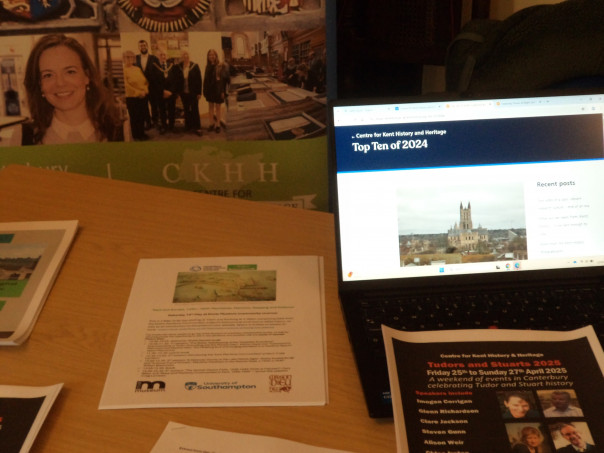
Moving on to Hull and Jason’s report (and many thanks for this), “the British Commission for Maritime History (BCMH), in association with the University of Hull, held its thirtieth conference for New Researchers on April 11. This annual conference was organised by BCMH and was supported by the Society for Nautical Research. The first day of the Hull maritime conference involved the exploration of the city of Hull and the discovery of the surprising delight of the Ambience tapas bar, where the food was gorgeous. It was a late lunch after a lengthy day on the train, and we then registered for the conference on Friday evening. The opening keynote presentation to a full room of conference delegates was delivered by Robb Robinson (University of Hull) who spoke on: ‘Interrogating a Ghost Ship of Grytviken’ – the story of Viola, the last surviving pre-World War I Hull steam or box trawler.
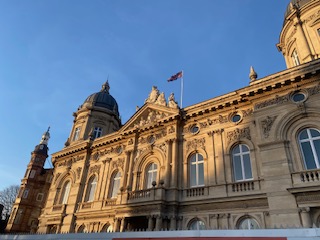
Arriving back at the conference early on Saturday morning, we were ready for the twelve speakers across the day who presented on a range of maritime projects from the global, through to national, and local contexts. Session One focused on the global and maritime space with very good panel presentations on ‘Captain John Wood’s 1676 Search for the North-East Passage’ by Peter Wells (University of East Anglia), ‘Expelling Pirates, Acquiring Sovereignty: The East India Company at Malvan, 1765-1812’ by Saanika Patnaik (Ashoka University), and ‘Customary law of the sea seen through literature: ‘Naufragios’ and troubles at the coastline of Spanish America’ by Matilda Sidel (University of Oxford). The latter presentation raised specific interests in the issue of sea boundaries and jurisdictions.
Session Two was entitled: Maritime Histories from Below and featured two excellent presentations from Eliška Bujkova (University of New Brunswick), ‘Bodies of labour and labouring bodies: colonial structures of care and bodywork in the British Atlantic c. 1650 to c. 1780’ and Kit Barton (University of Exeter), on ‘Reconstructing the World of the British Sailmakers; 1688-1714’. Kit Barton received a prize for her M.A. dissertation, and she is now undertaking her PhD as part of Early Modern Wills project. This uses the PCC probate records held at the National Archives and involves the digital transcriptions of 25,000 wills, which forms the basis for her research. Jason had originally been timetabled for a panel in the late afternoon, but due to a speaker being absent, was asked to present in this session before lunch (generously provided by Hull City County Council).
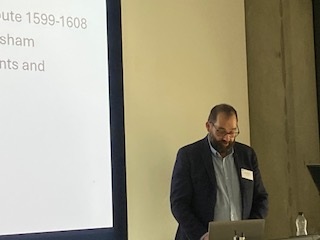
His presentation on late Elizabethan maritime communities and the oyster disputes was very well received as he created a snapshot of the lived experience of the merchants and mariners of Faversham as reflected through these oyster disputes, the coastal port books, and local probate records. For what emerges from the archives is a repository that bears witness to the past experiences of the merchant and mariner men. Jason started by displaying and explaining the significance of place for Faversham by using the Gough Map c. 1400 and maritime ways of seeing. Moving on to the 1608 Oyster Maps of Faversham, he explained the oyster dispute of 1599-1608 over the boundaries of the inned marshland and fishing grounds. Using a range of examples, the presentation explained how the agents present in historical probate records and the coastal port books made network linkages among a group of merchant/mariner men in the Faversham community. These were, in fact, Faversham seamen under another guise who appeared in many other town records in the period. The Colwells, Tillmans, and the Trowtes were well-known local merchant and maritime families, who were also contemporaries of the mayor, Christopher Fynche. Furthermore, they belonged to the same Company of Free Fishermen, and had ties to London, Kent, and beyond. Connections were established through commercial dealings, civic office holding, resource transfer, and kinship. As Jason exemplified, Faversham is an example of the gateway to the sea located in a complex network of relations between merchants and mariners. At the end of the presentation, Jason was asked a range of questions regarding the merchant and mariner men. Such questions included the trade between Faversham and the Dutch and Flemish contingents, the negotiation of ‘inned’ land between the sea and the landowners, and the usefulness of the concept of place in early modern Kent. The questions continued into lunchtime, and contact details were exchanged – signifying how well the session went.
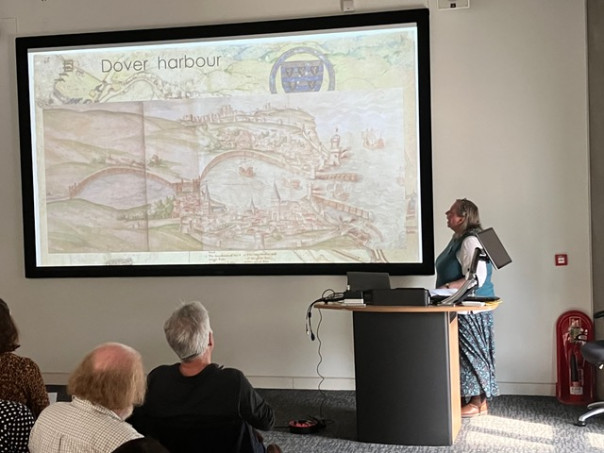
After lunch, Session Three was entitled New Naval Histories. The attendees enjoyed the presentations by Dave Brooks (University of Hull), ‘Patronage and Capability in the British Royal Navy 1815-1870’ and Paul O’Donnell’s (Birkbeck College, University of London), ‘The Vegetarian Dreadnought: the ship that was built for Liberals’.
This session’s opening presentation was given by Kieron Hoyle, who spoke on ‘Dover and the Narrow Seas: Trusted Experts of the Crown’. Her talk started with a brief history of the Maison Dieu and its significance for the town and port of Dover as a 13th-century pilgrim hospital, founded by Hubert de Burgh. She then examined the role of the Maison Dieu and its location to the port of Dover, including a brief mention of Calais and the Downs to provide a contextual setting. She mentioned the role of Clark and Thompson, the last two masters of the hospital, in the early development of Dover Harbour. John Clark is the first on record who, with the assistance of Henry VII, and the town’s mariners, created a sea wall and haven in the shallow waters called ‘Paradise Pent’. Nevertheless, Dover’s shallow harbour continued to suffer from what we now call longshore drift, the prevailing movement of sands and silts being from west to east along Kent’s shoreline, which led to considerable difficulties under the early Tudor monarchs. Moving on in time, Kieron then revealed is a tangled web of intricate relations, established through her use of a relational database, among Thomas Winter, Edward Baeshe, and Sir Thomas Digges. For example, Kieron explained these interconnections such as the surrender of the Maison Dieu to the Crown and Winter’s letter concerning looking for a suitable yard in Dover. While the newly established system of victualling under Baeshe gave the Maison Dieu the ability to be self-sufficient and supply full victualling for the navy, to be controlled by him and his assembled team, which resulted in less waste and the ability to supply ships quickly in time of need when a fleet was assembled even at short notice. Then Digges, as a mathematician and hydrologist, transformed Dover harbour using his engineering knowledge gained from the Low Countries, enabling a harbour system which worked for Dover.
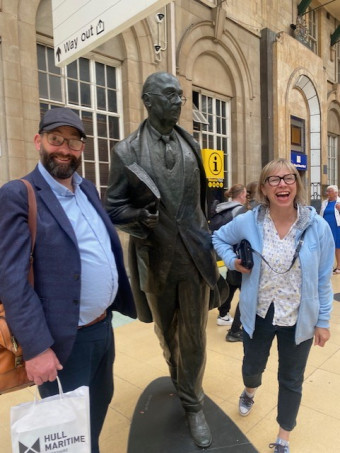
Indeed, Sir Thomas Digges’ work was crucial, for it was his observations of Dutch engineers and their understanding of the principles of hydraulic engineering on Dutch maritime defences that remedied the situation. Moreover, with his expertise, Digges, as a master surveyor, was also able to draw on the skills of men from Romney Marsh who were adept at constructing solid sea walls from earth and chalk, which meant that by 1583 the development of the harbour and its sea defences was a success. The victualling yard and the harbour’s re-design were put to the test during the Armada in August 1588, which marks the point where these two new systems developed by experts were tried and successfully tested in the victualling for the navy with speedier access to the narrow sea. In her presentation, Kieron eruditely examined these relationships and their importance to English and French history and, furthermore, exemplified the importance of the development of the Maison Dieu and Dover having gone hand in hand – a symbiotic relationship.
The final session of the conference was entitled from the Local to the National and began with an excellent presentation from Tom Gayton (University of Exeter), ‘Paid “like drops of blood”: Popular Allegiance in Dorset’s Ports in the Early Seventeenth Century’, which Jason especially enjoyed. It included a discussion of a dispute in Poole and neighbouring areas and Tom made great use of sixteenth-century Henrician maps. The final presentation was given jointly by Sophia Bella Chapple, Johannes Rom Dahl, Cianna Devitt (Trinity College Dublin), on ‘Marine Resource Use During Times of Adversity: A Mixed Methodological Approach to Studying 17th Century Scottish Adaptation’. This highlighted the value of Scottish Port Books and how the team was using optical scan recognition software to read these sources. They are in the process of exploring the trade of the Scottish ports, which mentioned a great deal about the oyster trade – and ultimately got Jason very excited!
After a fantastic day of speakers and apologies for not mentioning all of them here, the closing speeches were given by the event organiser, Dr Martin Wilcox (University of Hull), who led the proceedings over the two days. Thank you, Hull – a great city and a long journey home to Kent (not New Zealand as one delegate mistakenly believed), but well worth it nonetheless! And another thank you to the World Ship Society for providing Jason with a travel bursary.”
 Centre for Kent History and Heritage
Centre for Kent History and Heritage Sheila Sweetinburgh
Sheila Sweetinburgh 2163
2163

